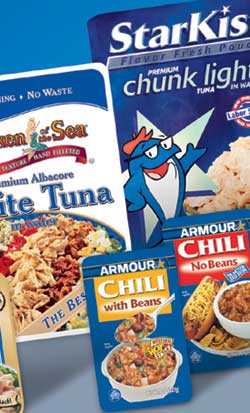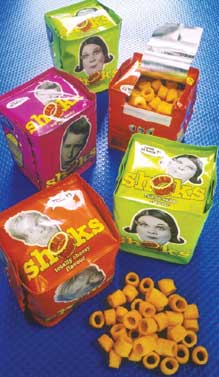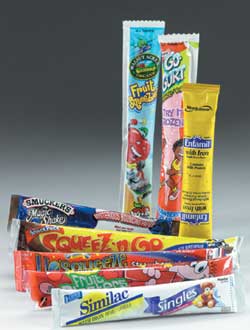
Consumers clearly understand the conveniences pouches offer such as resealability and portability. In addition production costs in both materials and equipment have decreased as pouch volume increases. “With the new equipment coming on line able to fill 500 stand-up pouches per minute and liquid beverages able to be filled at more than 1,000 pouches per minute, the costs are coming in line with the old packaging process speeds,” says Scott Lamerand, product manager, dry mix/confection/pet food for Pechiney Plastic Packaging.
Now that everything from cereals to soups to dried fruits to frozen potatoes are packed in stand-up and lay-flat pouches, what areas of conversion are left? “Any products still in boxes are great candidates [for conversion to stand-up pouches],” emphasizes Lamerand. “Other dry materials are sure to follow. A walk down the cake aisle in the grocery store also points out a large opportunity for transition.”
Because so many food and beverage products have moved into pouches, what was once a unique package on the shelf may now look commonplace. However, says Lamerand, “I see further differentiation taking place through unique shapes, inks and graphics.”
At the same time pouches are fighting to keep their distinction, brand managers are trying to keep their brand’s unique shape or graphics when transitioning from rigid packaging to pouches. “People spend so much building their brands and brand identities. When you look at the box to pouch movement, you see a lot of commonality of the old graphics and the new graphics just to hold the brand,” notes Lamerand.

Shape of things to come
One way pouches are differentiating themselves is through shape. To mirror other containers’ rigidity and stackability, many flexible pouches are taking on boxy shapes. For example Amcor Flexibles Europe recently supplied a mini version of its cube-shaped FlexCan for British snack maker KP Foods’ Hula Hoops Shoks snack brand. Available in three different flavors – Full-On Onion, Bigtime Saucy, and Totally Cheesy – the FlexCan structures are a 65 micron laminate of a metallized oriented polypropylene (OPP)-based film laminated to another OPP-based film with tear characteristics to provide easy opening.The pouches are filled on a modified Rovema VPI 260 intermittent vertical bagger as a result of the joint development of the FlexCan concept with Rovema Verpackungsmachinen.
While the U.S. originator of drink pouches, Kraft’s Capri Sun juice, holds 26% of the total global stand-up pouch market, according to Packaging Strategies’ study, many more beverage companies are moving in on its territory. Stand-up pouches have found a particularly lucrative market in the children’s juice drink segment. Cadbury Schweppes/Mott’s Hawaiian Punch juice drink in a 6.75 oz. clear, shaped pouch, which replaces the brand’s juice box, is one of many children’s juice drinks that are attempting to capitalize on the breakthrough success of Capri Sun.
Kraft has extended its pouch format to another of its flagship juice brands – Kool Aid. Kraft’s Kool-Aid Jammers are filled in a 200ml stand-up pouch featuring a clear back panel that displays the bright Kool-Aid colors. Alcan Packaging’s Lawson Mardon USA division manufactures the proprietary clear barrier structure for the pouch.
Another recent entry into pouched beverages is the result of the partnership between The Walt Disney Co. and The Coca-Cola Co. Disney Xtreme! Coolers are made with Minute Maid juices and packed in 200ml contoured pouches. The film for the pouch is supplied by Pechiney Plastic Packaging and the pouches are converted by Minute Maid in Paw Paw, MI.
Resealable, spouted beverage pouches – designed to remind the consumer of more conventional rigid recloseable plastic containers – are also increasing their presence in the U.S. market thanks to increased filling speeds. Many filling equipment manufacturers claim to supply systems that can fill up to 500 pouches per minute, the fill speed where pouches are competitive with plastic container filling speed. PPi Technologies recently introduced the new high-speed Nishibe 700SSTg machine which delivers pre-made stand-up pouches for beverages at 480 pouches per minute. These pouches are then loaded from four lanes into a Laudenberg FMB-88 continuous motion filler. PPi claims filling and sealing speeds on the Laudenberg machine can reach nearly 500 pouches per minute.

Taking the heat
As pouches become mainstream among certain food and beverage categories, the next large area of conversion is retorts for shelf-stable foods. While this application has been around for nearly 25 years, mainly as a three-sided seal pouch for military use MREs, it took off in 2000 when H.J. Heinz debuted StarKist tuna in a multilayer four-side-seal retort pouch. The commercial success of this product proved that just about any product packed into a bottle or can and retorted is a candidate for replacement by a pouch. Emerging product categories in retort pouches include soups, sauces, fruits, specialty meals, meat and poultry items, and seafood.
Many things are driving the interest in retort pouches in North America, notes Dean Hoss, president of The Pyramid Group, converter of Heinz’s StarKist tuna retort pouch. “We have had speeds increase from 30 a minute to over 500 a minute in just the last few years. This has aided in the transition from cans to pouches,” says Hoss. International food companies that have been using retort pouches overseas are now looking to co-packers in the U.S. that have invested in the faster running machines, adds Hoss. This allows entry into a test market without capital expenditure.

Material world
Materials are now available that can be both shelf-stable and microwaveable for use at home or at the office, says Hoss. This consumer convenience is helping to drive ready-to-heat-and-eat foods to the market. Material costs are also improving, says Hoss. As flexible packaging innovations and production speeds have improved, pricing has become very competitive to metal cans, Hoss states.Finally, the improved taste of food packed in retort pouches is a driving factor, adds Hoss, who notes that the retort time for cooking has been reduced as much as 57%, which results in better nutrients, flavor and product substance.
While initial growth of retort pouches was in foodservice/institutional markets where the retort pouch replaced the traditional #10 can, more consumer retail items are taking on growth, particularly as higher-value meat items start to move into retort pouches and are either sold singly or as a component in a meal kit. After the success of StarKist tuna in a retort pouch, other tuna brands such as Bumble Bee and Chicken of the Sea moved into single-serve pouches and pouches as components of meal kits. This is now happening in other protein food groups, says Hoss. “We will be seeing flavored protein items with kits that can take shelf-stable foods of different textures and mix and heat in seconds for a dinner.”
One indication that retort pouches have arrived is when large players in packaging such as Sonoco invest in the technology. The company recently introduced the Sonotort retort pouch in three variations: a four-ply foil pouch, a three-ply foil pouch, and a clear foil-free pouch. The four-ply pouch is constructed of polyester/ nylon/foil/cast polypropylene, while the three-ply pouch is a similar structure but eliminates the nylon. The clear foil-free version of the Sonotort employs a clear, aluminum-oxide-coated polyester barrier film which allows consumers to view the product and microwave it as well. Sonotort retort pouches range in size from 3 oz. to an institutional #10 food can-size equivalent and provide foods with a two-year shelf life.

Sidebar: Stick packs wiggle their way into diverse applications
A variation on the stand-up pouch is the flexible stick pack pouch, which got its boost into mainstream markets with General Mill’s widely successful Go-Gurt yogurt snacks. Now, one look in the yogurt section and you’ll find a plethora of stick packs. Beyond yogurt applications, stick packs are now used for everything from pudding to applesauce to peanut butter. As more food companies adopt stick packs, are they losing their uniqueness on the shelf?“Stick packs are still exciting as alternatives to traditional single-serve sachets among a diverse cross-section of marketing folks,” notes Neil Kozarksy, president of T.H.E.M. of Mt. Laurel, NJ, a company that has brought numerous Japanese stick pack technologies to U.S. markets and has exclusive North American rights to the SlimStick packaging system from Sanko. “While sticks as ‘go-snacks’ have taken off, there remains significant uncharted terrain in additional powder applications, including drink mixes, milk powder, cocoa, nutritional supplements and even sugar/sweeteners.”
According to Kozarsky, there is a “world of opportunity” for stick packs driven by consistent high marks from consumers, significant film efficiencies – up to 40% less material compared to three or four-sided seal pouches – and proven high-speed production. “Stick packs typically fare very well from a purely economic standpoint when compared to three and four-side seal pouches as they use significantly less film per impression,” notes Kozarsky. “Stick pack machinery is now capable of running 80-90 cycles per minute across as many as 26 lanes, depending on the flowability of the product and pouch configuration.”
Kozarsky adds that compared to thermoformed tubs and lid stock, the stick pack is less costly. “However, many companies inclined to switch to the stick have to grapple with machinery infrastructures that are fully amortized. Sticks will likely have a good chance to take over when new equipment is called for.”
In terms of upcoming applications for stick packs, Kozarksy notes that technology breakthroughs in dairy and more recently aseptic stick packaging are opening up new doors, particularly for low-acid products.
Recently ConAgra’s Hunt’s brand Squeez ‘n Go Portable Pudding debuted in a 2.25 oz. aseptic flexible stick pack. Curwood provided the three-sided film with a tear notch opening for the stick pack. The stick is produced at a speed of 400 packs per minute on a form/fill/seal machine from Hassia USA. The shelf-stable puddings are said to have a one-year shelf life.